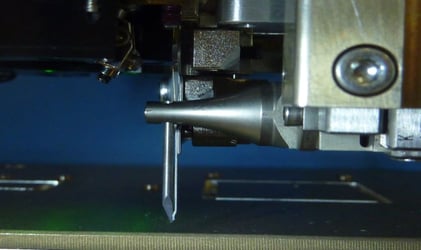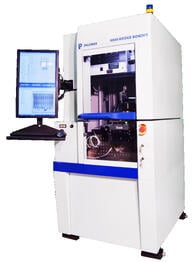Palomar/Hughes started designing and manufacturing wedge bonders in the early 1980s for the aerospace and defense industries. Later, these machines were used for a wider array of applications beyond just military, including medical devices, RF/Wireless packages, automotive sensor systems, and optoelectronic systems and components. Ultrasonic wedge bonding was introduced in the early 1960s.
Automated wire bonders were first introduced nearly 40 years ago. At this time, the majority of interconnects were made using aluminum wire. As the need for high reliability increased, gold wire became more common. As package densities increased, wire interconnect bond pitches decreased. The initial solution to the fine pitch challenge was wedge bonding due to the design of the wedge tool allowing wires to be bonded in close proximity (side-by-side).
Throughout the years, several features have remained common among wedge bonding equipment such as wire fed through the tool and the wire clamping behind the tool. Today’s wedge bonders are vastly different from those of the past, as well as performance capabilities differing from manufacturer to manufacturer. When selecting a wedge bonder, you should consider the following criteria:
Almost every wedge bonder is capable of handling all three types of wire. However, modern wedge bonders such as our 9000 Wedge Bonder, can handle all three wire types without changing the wire clamp.
Older wedge bonders have longer wire spans from de-spooler to wire clamp which renders poor control of the wire feed. The wire, especially ribbon wire, can easily be twisted and affect the bonding quality. The advanced wedge bonders of today have overcome such obstacles.
Older wedge bonders are designed to specifically cater to one type of wire feed angle. If you have a wedge bonder equipped with a 45-degree wire feed angle, you cannot use it for deep access bonding applications without replacing the entire bond head with a deep access wire clamp. Not only is this costly, but it is also very time consuming to change the bond head because the bonder may have to stop production for a couple of days during the conversion. The good news: modern wedge bonders have done away with bond head changes and are now capable of converting from a 45/60-degree to 90-degree wire feed.

Programming wires can become a nightmare, particularly when the number of wires runs into the hundreds and thousands. Our modern wedge bonders are now equipped with user-friendly intelligent interactive graphical interface,i2Gi®, as a standard feature which allows the management from part design and development, to process validation and finally to intuitive operations control.
Older wedge bonders use a physical contact to learn the heights of the surface to be bonded when learning or transferring programs onto a machine.
The method is slow, time-consuming, and can cause damage to the parts. However, modern wedge bonders are intelligent enough to learn the heights without

having to make physical contact with the parts providing protection to the valuable parts.The 9000 Wedge Bonder has auto focus with part height update which is useful during production runs to better handle part height variations.
__________________________________________________________________________________________________________________
This is a guest post by Palomar Technologies, formerly Hughes Aircraft, which is the global leader of die attach solutions, wire bonding equipment, optoelectronic packaging systems and precision assembly services.